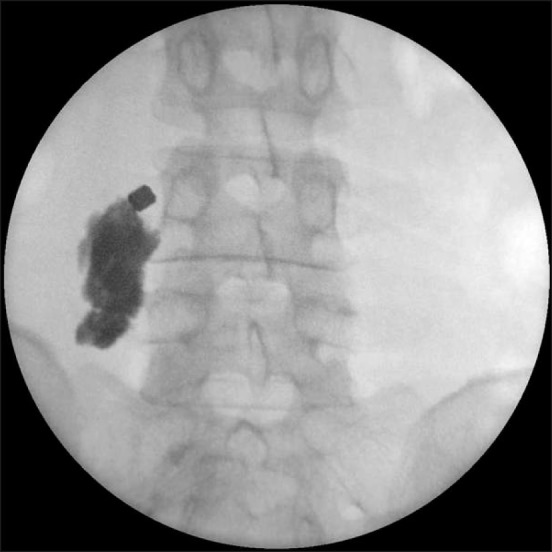Korean J Pain.
2017 Jan;30(1):62-65. 10.3344/kjp.2017.30.1.62.
Psoas compartment block for treatment of motor weakness and pain following herpes zoster
- Affiliations
-
- 1Department of Anesthesiology and Pain Medicine, Kyungpook National University Hospital, Daegu, Korea.
- 2School of Dentistry, Kyungpook National University, Daegu, Korea. jeon68@knu.ac.kr
- KMID: 2365343
- DOI: http://doi.org/10.3344/kjp.2017.30.1.62
Abstract
- Reactivation of the latent varicella zoster virus in the sensory ganglion causes herpes zoster (HZ). Its characteristic symptom is a painful rash in the involved dermatome. HZ-induced motor weakness is rare and is usually resolved within one year of the onset, but some patients permanently experience motor dysfunction. Epidural steroid administration, with antiviral therapy, can be effective in treating pain from HZ and preventing postherpetic neuralgia. But an epidural block is contraindicated in patients receiving thromboprophylaxis. A psoas compartment block (PCB) provides equivalent analgesic efficacy with significantly low incidence of complication, compared to an epidural block. A 68 year old male patient recieving thromboprophylaxis presented with motor weakness following painful rash in his left L4 dermatome. Ten days before presentation, herpetic rash occurred on his left leg. We performed PCB with a steroid and local anesthetic, which successfully and safely alleviated the pain and motor weakness from HZ.
Keyword
MeSH Terms
Figure
Reference
-
1. Jeon YH. Herpes zoster and postherpetic neuralgia: practical consideration for prevention and treatment. Korean J Pain. 2015; 28:177–184. PMID: 26175877.
Article2. Lee MH, Song JH, Lee DI, Ahn HS, Park JW, Cha YD. Newly developed urinary retention and motor weakness of lower extremities in a postherpetic neuralgia patient. Korean J Pain. 2013; 26:76–79. PMID: 23342213.
Article3. Chernev I, Dado D. Segmental zoster abdominal paresis (zoster pseudohernia): a review of the literature. PM R. 2013; 5:786–790. PMID: 24054853.
Article4. Kim JG, Chung SG. Herpetic brachial plexopathy: application of brachial plexus magnetic resonance imaging and ultrasound-guided corticosteroid injection. Am J Phys Med Rehabil. 2016; 95:e67–e71. PMID: 26829085.5. Kumar V, Krone K, Mathieu A. Neuraxial and sympathetic blocks in herpes zoster and postherpetic neuralgia: an appraisal of current evidence. Reg Anesth Pain Med. 2004; 29:454–461. PMID: 15372391.
Article6. Vandermeulen EP, Van Aken H, Vermylen J. Anticoagulants and spinal-epidural anesthesia. Anesth Analg. 1994; 79:1165–1177. PMID: 7978443.
Article7. Moen V, Dahlgren N, Irestedt L. Severe neurological complications after central neuraxial blockades in Sweden 1990-1999. Anesthesiology. 2004; 101:950–959. PMID: 15448529.
Article8. Türker G, Uçkunkaya N, Yavaşçaoğlu B, Yilmazlar A, Ozçelik S. Comparison of the catheter-technique psoas compartment block and the epidural block for analgesia in partial hip replacement surgery. Acta Anaesthesiol Scand. 2003; 47:30–36. PMID: 12492794.
Article9. Florence JM, Pandya S, King WM, Robison JD, Baty J, Miller JP, et al. Intrarater reliability of manual muscle test (Medical Research Council scale) grades in Duchenne's muscular dystrophy. Phys Ther. 1992; 72:115–122. PMID: 1549632.
Article10. Jones LK Jr, Reda H, Watson JC. Clinical, electrophysiologic, and imaging features of zoster-associated limb paresis. Muscle Nerve. 2014; 50:177–185. PMID: 24638224.
Article11. Mondelli M, Romano C, Rossi S, Cioni R. Herpes zoster of the head and limbs: electroneuromyographic and clinical findings in 158 consecutive cases. Arch Phys Med Rehabil. 2002; 83:1215–1221. PMID: 12235600.
Article12. Conliffe TD, Dholakia M, Broyer Z. Herpes zoster radiculopathy treated with fluoroscopically-guided selective nerve root injection. Pain Physician. 2009; 12:851–853. PMID: 19787010.13. Horlocker TT, Wedel DJ, Benzon H, Brown DL, Enneking FK, Heit JA, et al. Regional anesthesia in the anticoagulated patient: defining the risks (the second ASRA Consensus Conference on Neuraxial Anesthesia and Anticoagulation). Reg Anesth Pain Med. 2003; 28:172–197. PMID: 12772135.
Article14. Kim S, Jeon Y. Treatment of abdominal segmental hernia, constipation, and pain following herpes zoster with paravertebral block. Pain Physician. 2015; 18:E927–E929. PMID: 26431148.15. Parkinson SK, Mueller JB, Little WL, Bailey SL. Extent of blockade with various approaches to the lumbar plexus. Anesth Analg. 1989; 68:243–248. PMID: 2919761.
Article



